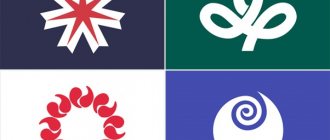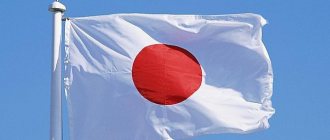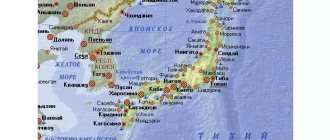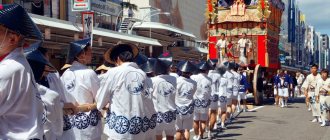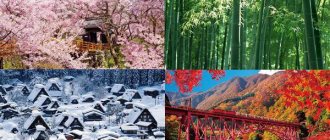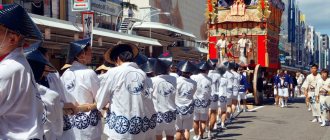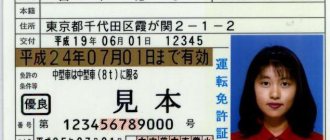The national flag of Japan is familiar to almost everyone; its laconic design with a red circle against a white background represents the sunrise. The history of the Japanese flag goes back a long way and, according to some sources, dates back to the 13th century. The idea to depict the solar circle was suggested by Buddhist monks, since according to legend the Japanese emperor is considered a descendant of the sun goddess. This idea was supposed to unite the subjects of the empire, since during that historical period Japan was subjected to a Mongol invasion.
The flag of Japan has two official names: Hinomaru, which means “sun disk” in Japanese, and Nisshoki, which literally means “sun flag”. It should be noted that each prefecture in Japan has its own unique flag. The image of each of them carries a hidden meaning. For example, the Tokyo flag is a green leaf, representing prosperity. And the blue background of the Hokkaido flag characterizes the deep sky and sea of the prefecture. The red star depicted on it symbolizes the irrepressible energy of the people living here.
Symbolism
The red circle on a white background symbolizes the sun, which rises in the east and illuminates the earth, giving people warmth and light.
The teachings of Shinto explain the colors of the cloth. Red is the color of life, the dawn sun and sacred fire, burning out misfortunes and vices. The white background is associated with truth and purity.
The design of the panel plays on the informal name of Japan - the Land of the Rising Sun. The origin of the nickname dates back to the 7th century. The first mention of the Japanese emperor as “Lord of the Land of the Rising Sun” was found in state correspondence with China.
The connection between the state flag and the historical symbols of the Imperial Court.
The coat of arms is considered one of the important symbols of each state, but Japan is an exception to global standards and therefore this country does not have official coat of arms. The main role was played, of course, by the development of the state, isolated from the outside world, in which such a thing as a coat of arms simply did not exist.
As you know, the very concept of a coat of arms goes back to the Middle Ages. For the first time, coat of arms symbols began to be used by knightly orders, then this tradition spread throughout Europe, as well as in connection with the Crusades and among eastern countries. Isolated from the outside world, Japan was not aware of the traditions of Europe until the middle of the 19th century, but there was still an official symbol. The image of a sixteen-petalled chrysanthemum flower with petals in two rows was the emblem of the Imperial House for many centuries, and since all military forces were subordinate only to the emperor, as the supreme military leader, we can say that the symbolism of the ruling council was the coat of arms. The official name of this symbol is “kikukamonosho”, which literally means “coat of arms in the form of a chrysanthemum flower.”
The history of this emblem dates back to the reign of Emperor Kakamura (1183-1198). According to legend, this ruler had a special affinity for chrysanthemum flowers and used the image of the flower as a personal seal; this tradition was continued by subsequent rulers. Thus, the symbol of the chrysanthemum was firmly entrenched in the official symbolism of the imperial dynasty. The shape of the flower inscribed in a circle has a close connection with the solar disk, which is traditionally identified with the imperial family.
Official recognition
The official recognition of the sixteen-petalled chrysanthemum as a symbol of the ruling emperor dates back to 1869, which is a year later than the adoption of the state red and white flag. In 1871, in connection with the empire's significant role on the world stage, a decree was issued banning the use of the coat of arms by persons not belonging to the imperial family. As the official symbol of the Great Japanese Empire, the coat of arms of the imperial family was depicted on the bows of warships during the Second World War, after which the ban on the use of symbols by non-members of the Imperial House was lifted. Now the order in the form of a chrysanthemum is the highest state award, and this symbol is also depicted on the international passports of Japanese citizens.
For the peoples of Japan, chrysanthemum is a kind of personification of wisdom and prosperity. Her image has a direct connection with the sun located on the country’s flag. One of the most ancient legends is associated with this beautiful flower. According to legend, the powerful Chinese emperor learned about a miraculous flower growing nearby and decided to create an elixir of longevity from its juice. But only a person with a kind heart and soul could pick this flower. Therefore, the emperor gathered the most sensitive and responsive young men and women and sent them to collect chrysanthemums. The people who came were fascinated by the beauty of the flower. They did not carry out the order of the emperor, but remained in the new territory, where they founded a new country - Japan.
The flag and coat of arms of Japan go far back to the origins of a great and united empire. The test of time has proven the attachment of its people to historically formed symbols. The flag of the country of Japan, represented by the most ancient canvas with the symbol of the solar disk, is kept on the territory of the Umpo-Ji fortress, located in Yamanashi Prefecture. This banner is considered a valuable relic belonging to the Takeda clan and is over a thousand years old. The history of the ancient flag of the land of the rising sun is shrouded in no fewer legends than the history of the origin of official symbols, according to one of them, the flag of the Takeda clan belonged to the leader of the Yoshimitsu clan, who in turn received it as a gift from Emperor Go-Ryozei.
The Japanese armed forces had their own flag, somewhat different from the one that symbolized the empire. A similar red circle was depicted on a white background. The difference was the presence of arrows extending from it, like the rays of the sun. There were sixteen of these arrows. And this is no coincidence. This number was a reference to the imperial power of the country.
Today, the flag of Japan appears before us in its original form and has the same functions as before.
Story
Early mentions of Japanese sun emblems are found in literary sources of the 12th century. The legend “About the House of Taira” mentions samurai fans with celestial patterns.
In the 13th century. The first Hinomaru flag was presented to the Japanese emperor by a Buddhist monk. The cloth was intended for the battle between the Japanese and the Mongols. The sun emblem was a reminder of the emperor's divine origins. The ruler was considered a direct descendant of the sun goddess Amaterasu.
In the 16th century Hinomaru flags spread among Japanese military leaders. The cloths played the role of a talisman. By raising the flag with the sun, the commanders ensured themselves the support of higher powers.
In the middle of the 19th century. The hinomaru became the distinctive sign of the state ships of Japan. In 1868, the first banner of the imperial army was developed - a red sun with 16 rays, placed on a white background.
Towards a modern image
In 1870, the sun flag established itself as a national symbol.
The image coincides with the modern design, but the shape of the flag was more elongated: the aspect ratio was 7:10.
During this period, Japan was experiencing the era of Meiji "enlightened rule". The country developed contacts with the outside world. The development of state symbols is a necessary measure to organize communication with other countries.
In 1885, the Meiji innovations were partially reversed. Legally, Hinomaru lost its status as a state symbol, but changes in legislation did not affect the practical use of the cloth.
In 1889, the flag of the Japanese Navy was created. A red sun with 16 rays was located on a white field to the left of center.
Since the beginning of the 20th century. Japan intensified its external expansion. Hinomaru rose during the Russo-Japanese War and armed conflicts with China and Mongolia. In the conquered territories, the white and red cloth was used for the ideological education of the population. The flag of the conquering country was raised not only on the streets, but also in schools in the new provinces. The children sang the Japanese national anthem while the hinomaru waved above their heads.
In the eyes of the international community, the solar flag was associated with the image of an eastern aggressor.
In 1945, after defeat in World War II, Japan came under US control. The use of state symbols was prohibited. To raise Hinomaru, permission from the American military administration was required. In 1949, occupation restrictions were lifted.
Japan changed its flag
In 1999, modern legislation on the state symbols of Japan was adopted. The act established the official status and modern proportions of Hinomaru. The aspect ratio became 2:3, while the old Japanese flag had 7:10.
In 2008, the Japanese Ministry of Defense made recommendations regarding the production of national flags. The clarifications affected the fabrics and colors of the design.
History of the creation of the flag
The flag was designed by Buddhist monks. One of them, Nichiren, presented such a banner to the shogun as a blessing, a sign of the fight against the Mongol invasion. The idea to create a flag arose under the influence of the legend about the origin of the Japanese imperial family from the sun goddess Amaterasu. The sun goddess is one of the main deities.
According to Shinto beliefs (Shinto is the dominant religion in the country), all Japanese emperors are direct descendants of gods. The Japanese believe that when the ruling dynasty changes, replacing her family, the sun goddess will turn away from them. Then the inhabitants of the country will experience terrible torment.
The appearance of the flag happened in the 13th century, when the country experienced a Mongol invasion. The idea was to unite all the emperor's subjects under the created flag.
The Japanese flag is known by two names: Hinomaru - solar disk, Nisshoki - solar flag. If there is a national flag, each prefecture also has its own flag.
Armed Forces Flags
The Japanese military flag is called Kyokujitsu-ki - “Flag of the Rising Sun”. The design feature is the presence of sun rays. Japanese military flags have been in use in their modern form since 1954.
- The symbol of the ground forces is a red sun with 8 rays, placed on a white field with gold trim around the edges.
- The flag of the naval forces - a solar disk with 16 rays is depicted on a white background and is offset to the left relative to the center. The flag follows the design of the 1889 naval ensign, but is a brighter shade of red.
Official approval of the national flag
The red and white cloth appeared many centuries ago, but began to act as the state flag in the mid-19th century. True, then it had different sizes and proportions: 7x10 and a circle slightly shifted to the left. Now the dimensions of the rectangular flag are 2x3, and the red circle is exactly in the middle. Many institutions use the old-style flag during the raising ceremony, considering it more elegant and elegant. Red and white remain the same colors from the beginning.
In 1870, the Hinomaru was declared the flag of the merchant marine. Until this time, Japanese ships traded with America and Russia and sailed under different types of hinomaru. Now they have been identified. Hinomaru became the first national flag that the country adopted until 1885.
The Japanese flag has a long history; it goes back to a distant time, when one of the great empires was born and united. However, it was only recognized by law as the official symbol of the country in 1999. The date of adoption of the law - August 13 - became the day of the national flag.
Flags of the Imperial Family
- The emperor's standard is a red cloth with a golden chrysanthemum in the center. The flower emblem serves as the national emblem of Japan. The image is taken from the emperor's personal seal. Chrysanthemum has been associated with happiness and longevity since the 12th century. considered the family sign of the imperial family.
- The empress's personal flag repeats the colors and design of her husband's standard. On the side of the panel opposite the shaft there is a dovetail cutout.
- The standard of the heir to the throne also has a triangular cutout. The chrysanthemum is surrounded by a white frame.
Why were the flags of militaristic Japan hung in Vladivostok on Victory Day?
Russian media widely reported how in Vladivostok the streets of the city were decorated with flags similar to the banners of the imperial navy and ground forces, under which militaristic Japan sowed death and destruction in China, Korea and other samurai-occupied countries of East Asia. “In Vladivostok they hang these standards... the Order of the Patriotic War against the background of the flag of the rising sun of Japan,” residents of the Russian city, which was occupied under such banners by Japanese invaders in 1918-1922, were indignant.
There are more and more cases of German tanks and Nazi crews in bombers being placed on posters dedicated to the Great Victory of the Soviet people. Let us recall the 2015 publication in one of the Russian publications: “They fought for the Motherland” - Russians were “congratulated” on May 9 with a poster with German pilots of the Second World War. A scandalous poster appeared in Ivanteevka, near Moscow. Russian designers captioned the photo of Hitler’s pilots “They fought for their Motherland.” Russian publicist and blogger Vladimir Golyshev commented on the photo on Facebook: “I no longer believe in accidents... The German crew in the cockpit of a Ju-88 bomber from the 71st Bomber Squadron (KG71). What kind of “jamb” is this? Fifth? Sixth? They say that in order to save money, design was entrusted to students... Has the shift really grown?! Isn’t it all in vain?!!”
Then the online newspaper Obozrevatel published a selection of Russian posters for Victory Day, created on the basis of famous photographs of American and even German soldiers during World War II.
Here are the recent facts. Last year, the Orenburg mayor's office hung a poster with a photo of the Nazis instead of the Red Army soldiers for the 75th anniversary of the Victory. In 2021, the facades of houses in Kurgan were “decorated” with banners with spelling errors by May 9. They contained the signatures “Defense of Sevostopol” and “Brest Fortress”.
In connection with the hanging in Russian cities of photographs of fascists instead of photographs of Red Army soldiers, one cannot help but recall the citizens of our country who placed photographs of Nazi leaders and the traitor Vlasov on the Immortal Regiment Online website. After this, the descendants of Soviet soldiers like “Kolya from Urengoy” no longer look so amazing, who, for handouts in the form of an invitation to Germany, are ready to express sympathy for the murderers from the Wehrmacht and SS, who suffered “hardships” on the Soviet-German front and “innocently died in battle.” .
However, let’s return to Vladivostok and the city’s decorations with Japanese militaristic banners. What are these banners that the designers of the holy Great Victory Day for our people liked?
Rising Sun Flag
The Rising Sun Flag (旭日旗 Kyokujitsu-ki) is the military banner of Japan. It was first used as a military banner at the end of the Edo period (since 1854). On January 27, 1870 it was adopted as the national flag. Currently, the flag continues to be used by the naval and, in a modified form, the Japanese Ground Self-Defense Forces.
Modern flag of the Japanese Ground Self-Defense Forces
During World War II, the flag was used by Japanese troops during the conquest and occupation of Southeast Asia, the enslavement of Korea and China. There it is considered a symbol of Japanese militarism and imperialism, and its use is offensive.
Japanese naval ensign from 1889 to 1945 and 1954 to present
In 2021, the Japanese authorities attempted to demonstratively send Self-Defense Force ships flying the Rising Sun Flag to participate in the international naval parade in the Republic of Korea, although the Korean authorities asked to refrain from doing so. The then Japanese Minister of Defense Itsunori Onodera made a statement at a press conference: “A warship, according to our law, is required to display its flag. According to international conventions, the flag also serves as a distinctive sign of the nationality of the ship. Therefore, we will definitely raise it.”
In response, the South Koreans proposed using the national flag on Japanese ships - a white cloth with a scarlet circle in the middle, but without diverging rays. Then official Tokyo, not wanting to change its decision to fly the naval flag of Imperial Japan, announced its refusal to participate in the parade.
The DPRK government also opposes the use of the Rising Sun flag in Japan, which is considered a symbol of militarism. “This is the war flag that the Japanese imperialists of the 20th century used when carrying out their barbaric invasions of our country and other Asian countries,” said the press service of the DPRK representative.
In South Korea, the Japanese news agency Kyodo Tsushin reported, there is a growing movement against the appearance of Japanese ships with an unwanted flag in the country's waters.
Well, the Vladivostok authorities, “admitting a mistake,” hastily replaced the symbol of Japanese militarism with the Russian flag. In this regard, the website of the Tsargrad TV channel wrote: “Far Eastern officials are accused of mistakenly “handing over the Far East” to the Japanese. We are talking about the strange flags with which the city was “decorated” for May 9 - residents considered them a provocation. According to Vladivostok residents, in this form the flags are very similar to the flag of the Japanese Navy. That is, the city authorities, intentionally or not, “handed over” the entire city to the Japanese. True, the city hall has already found the culprit: they said that the contractor who made the flags misunderstood the terms of reference for the design of the streets. They promised to replace the “scandalous” flags, and the manufacturer would not receive payment for incorrect flags. According to the latest data, tricolors have already been placed in the city instead of “Japanese” banners.”
However, such frequent “mistakes” by unnamed “contractors” lead to suspicion. Isn’t it time for such blasphemous acts to be dealt with with all severity, not limited to small fines?
Header photo: RBC
Data
- On August 13, Japan celebrates Hinomaru Day.
- According to 2008 regulations, military flags must be made of synthetic materials - nylon and acrylic.
- The old flag is subject to ceremonial burning in a private setting.
- "Hachimaki" is a Japanese headband in the shape of the national flag. Local residents see her as a personal talisman. The bandage is worn by everyone who wants to avoid misfortunes and strengthen strength: women before childbirth, students, office workers and athletes at competitions.
- Using Hinomaru as a commemorative card is a Japanese tradition that began during World War II. Paper images of the flag with good wishes were sent to the warring Japanese and were considered a protective amulet. The only condition is that the inscriptions must be located outside the solar disk.
- In the territories of Korea and China that survived Japanese occupation, hanging a Hinomaru is considered an insult to the nation.
Interesting facts about the Japanese flag
Five facts about the Japanese flag.
- Since its first raising, the flag has never changed.
- Before 1999, the aspect ratio was 7:10, after - 2:3.
- Flag Day in Japan is celebrated on August 13th. Date when the symbol's last design was adopted in 1999.
- The circle occupies 3/5 of the entire panel.
- The color of the Hinomaru circle changes frequently. In the eighteenth century it was dark red, in 1999 it became scarlet. It is often replaced with deep red.
